One of the problems that had to be solved when missiles first went to sea was how to carry and launch weapons that were not only bigger and heavier than anything that had previously been carried aboard, but also fragile and complicated, and which had to be fired in quick succession. To make matters worse, each ship could carry only a limited number of missiles, so provisions were also needed for replenishing weapons at sea.
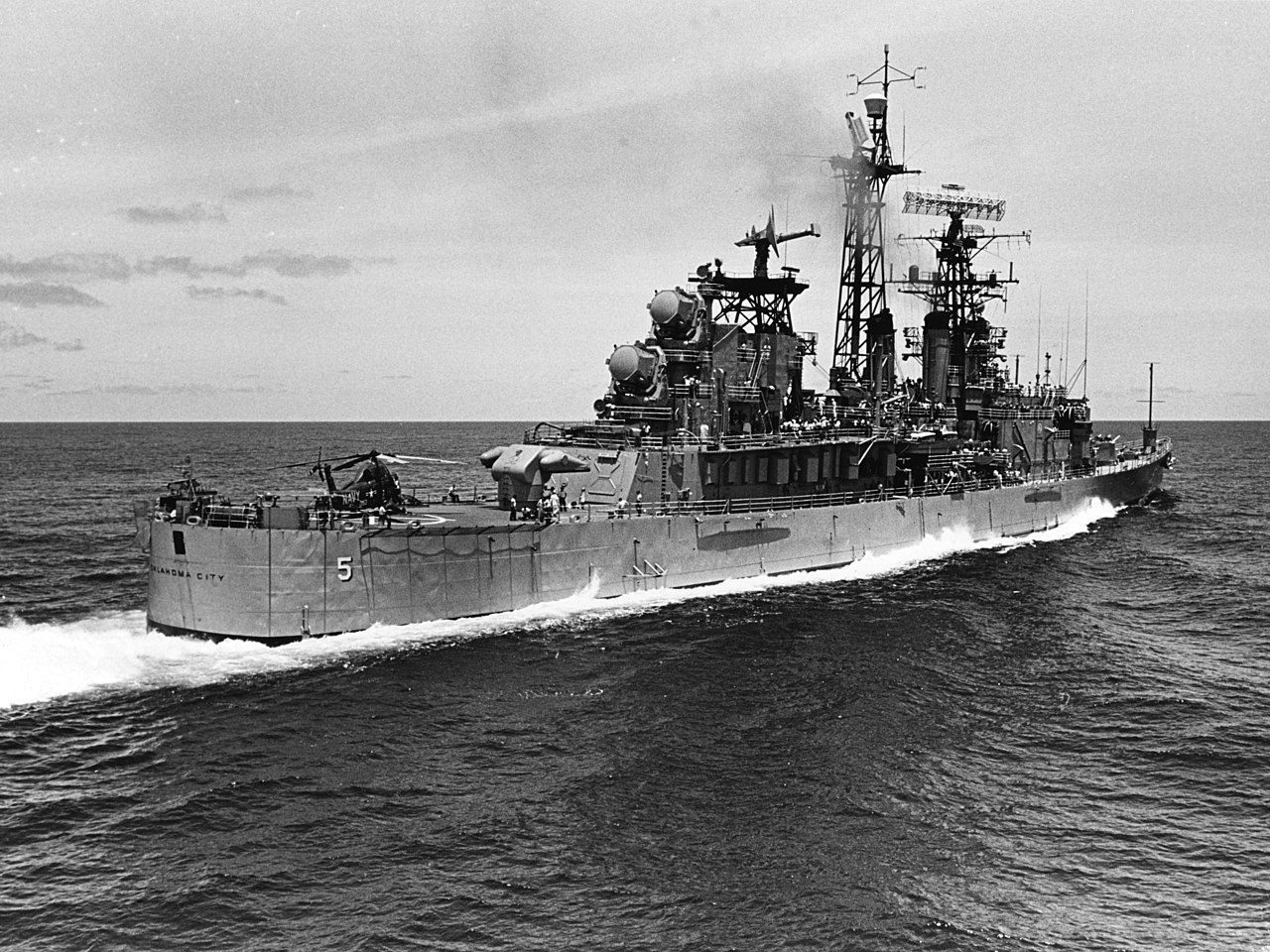
USS Oklahoma City showing her Talos launcher and radars
As the Terrier and Talos missiles had separate boosters, the initial plan was to store the majority of the missiles broken down to fit as many as possible aboard. The problem was that this would sharply limit the rate of fire after the ready-service missiles had been expended, and it soon became clear that the missiles could generally be stored assembled. To shrink the space required, they would be stored without fins, which only took 15 seconds or so to install by a dedicated crew in the last space before the missile was rammed onto the launcher. This wasn't likely to be a serious limitation on the firing rate, as each missile or salvo required a dedicated illuminator throughout its flight. But that still left the question of how to store and transport the missiles, and the Navy came up with a number of different solutions, many of which were installed on various ships.
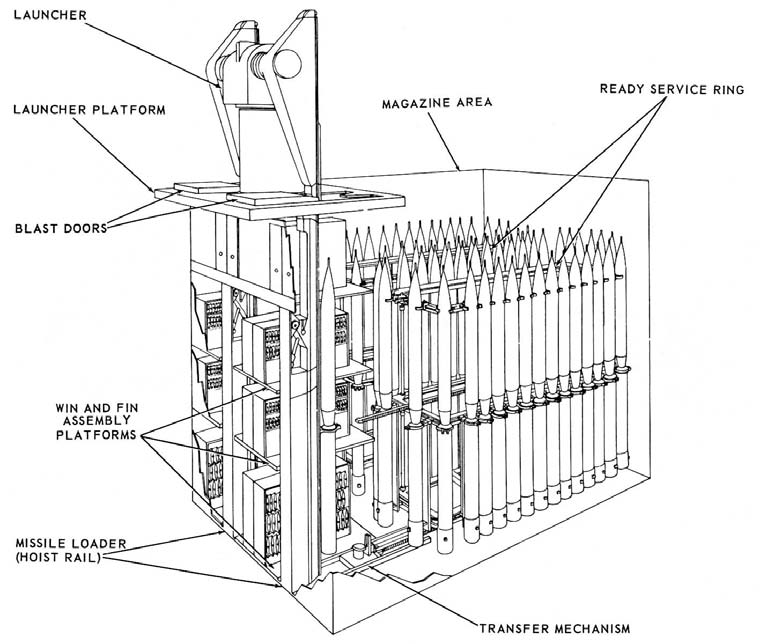
Mk 4 launcher, as used on Boston and Canberra
The big question was if the missiles should be stored vertically or horizontally, a decision that had implications not only for the design of the launcher, but also the broader ship. Horizontal storage would dramatically increase the amount of precious centerline space the system took up, but it was less mechanically complex. Vertical storage, on the other hand, required sufficient hull depth to accommodate the missiles, which completely ruled it out for Talos and made it dubious for Terrier on anything smaller than a heavy cruiser, but put the missiles inside the armor. The Navy ultimately chose the later option for the first guided missile ships, the converted heavy cruisers Boston and Canberra. The Terrier missiles were stored on a revolving vertical rack known as the "Coke machine" for its resemblance to contemporary soda vending machines, then transferred to the finning station and rammed. The launcher itself had two rails, each of which had its own magazine rack and rammer, and after it was loaded, it would drop from vertical to the appropriate elevation and train to fire the missiles into the guidance beam.1 If the missile turned out to be a dud, a pair of pneumatic jettison ram were built into the deck, one for each rail. The launcher would slew to the appropriate position, and then the ram would engage with the dud missile and throw it over the side, clearing the rail for the next missile. In practice, these were rarely used,2 but they were an important consideration in system design.
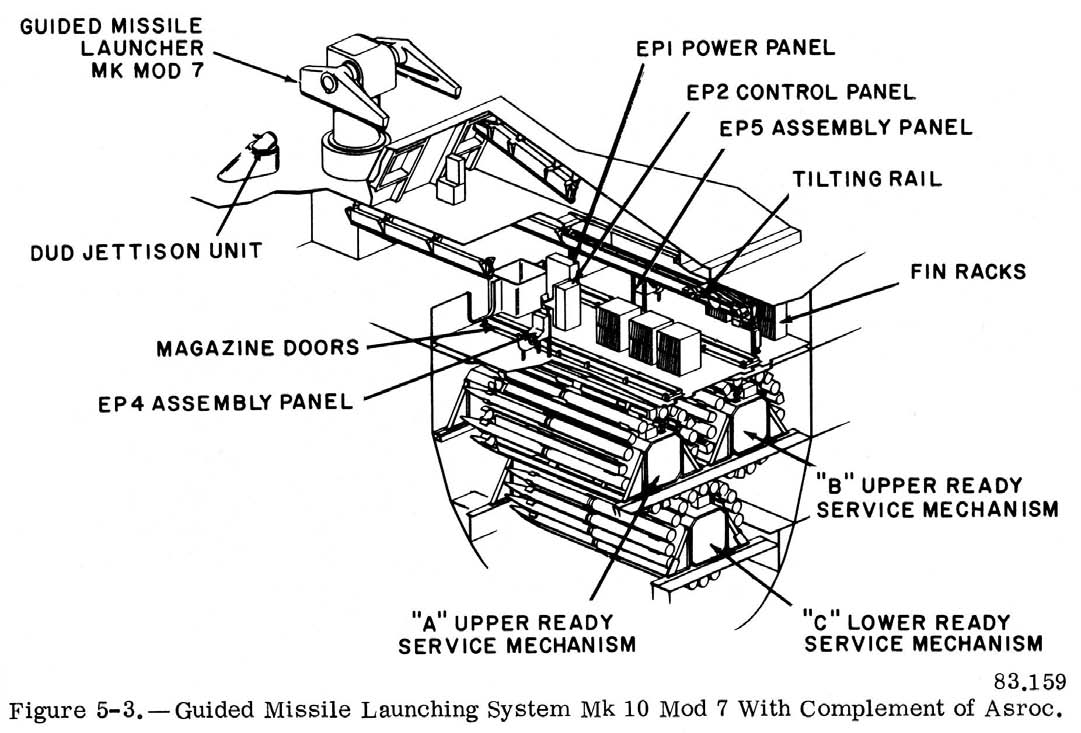
Mk 10 Terrier launcher
But Boston and Canberra were the only Terrier ships that carried their missiles vertically. The majority of ships used the Mk 10 launcher, which carried its missiles in a series of 20-round rotating rings. The most common version had three rings, two directly under the finning room and a third in the center below them that would pass missiles to either of the other rings to keep them topped up. From the finning room, which often doubled as the strikedown/checkout space, the missiles would be tilted upward to be rammed onto the launcher. The Mk 10 also introduced a new capability to the system, as half of the slots in the upper two rings could be occupied by ASROCs, which could be rammed and fired using an adapter that let them fit the rail. Afterwards, the adapter had to be withdrawn from the rail and sent back to the rings, but this was considered acceptable given that the system hopefully wouldn't have to engage air and subsurface targets at the same time.
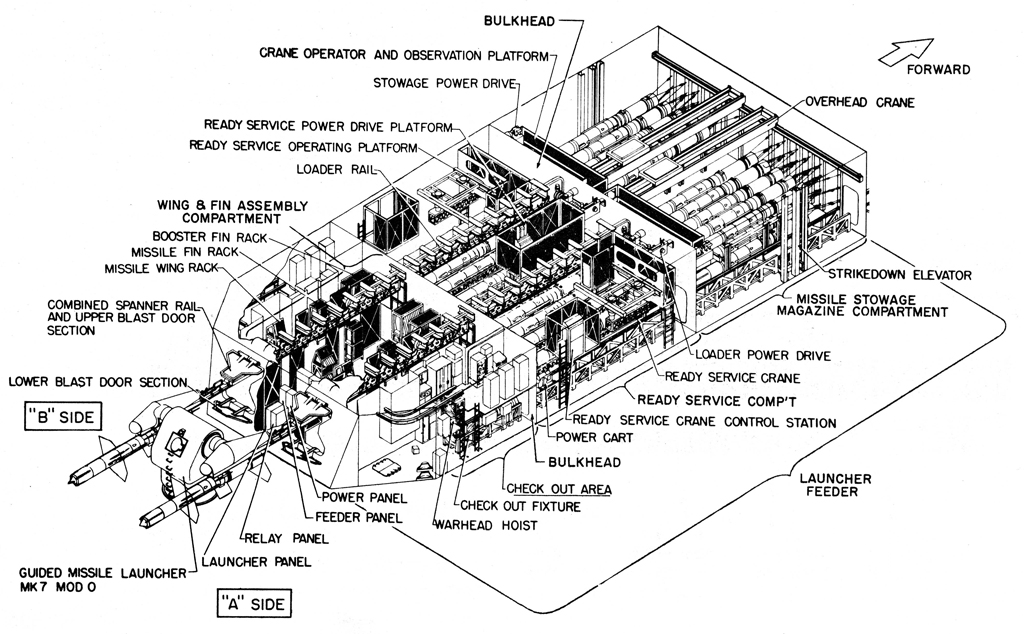
The Talos Mk 7 system
Talos was too large for a ring system, and the initial Mk 7 launcher, installed on the converted light cruisers Galveston, Oklahoma City and Little Rock, was quite primitive, with the entire system designed to go above the armored deck. The booster and missile were stored separately in racks in the magazine, 15 for each side, and lifted by crane for transfer to the forward ready service magazine where they were assembled and stored for use. Strikedown was done via overhead hatches into this area, with the missiles coming aboard via highline, and being moved via cart. Each side held 8 assembled missiles in a set of rotating trays, and they would be hoisted onto the rammer rail for transfer into the finning area. There, the crew would install the 12 fins required for each missile, with each man having a foot pedal to indicate that he was safely out of the way after his fins were installed. Then the blast doors would open, the rail would extend, and the missile would be rammed out onto the launcher. Outboard of the finning areas were the test cells, where each missile would be sent once a month to be checked out, a particularly annoying task if the required missile was at the bottom of the rack in the back magazine.3 Later Talos ships had the improved Mk 12, which stored the missiles fully-assembled in a below-decks magazine, up to 28 missiles per side, and using horizontal trays and an elevator, all could be accessed readily.
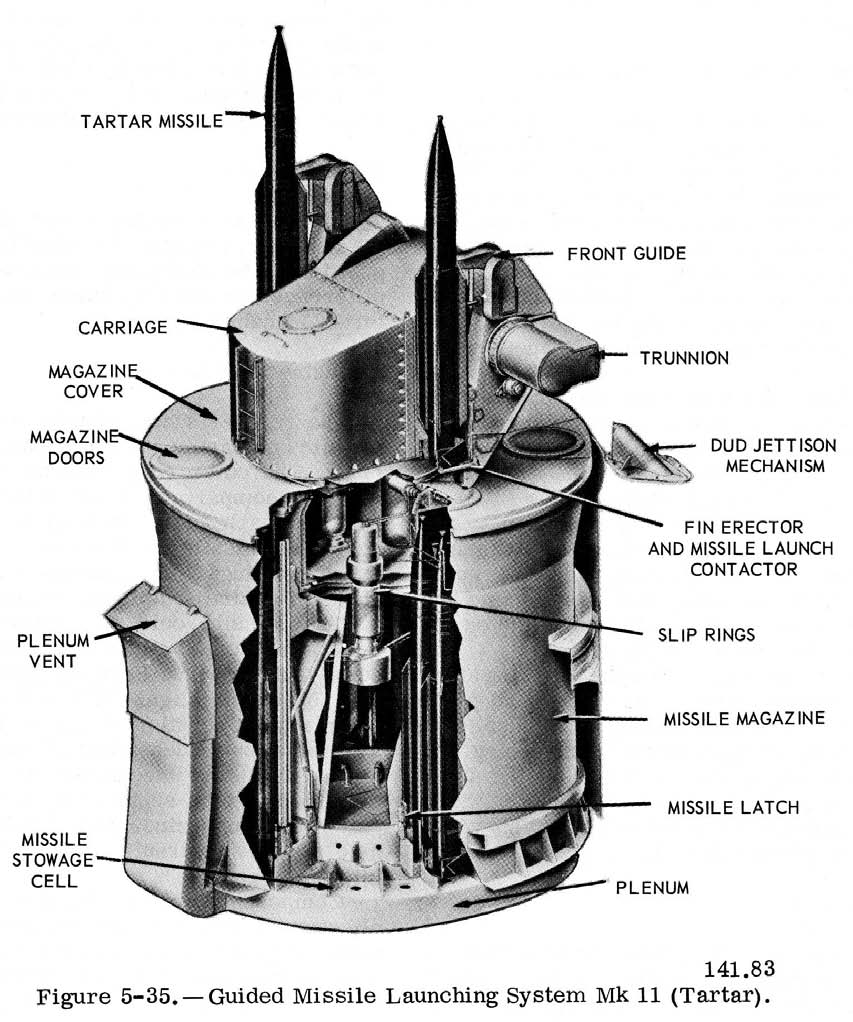
Mk 11 Tartar launcher
But while Talos was too big for the ring system, the opposite was true of Tartar, which proved well-suited not only for rings but also for vertical storage. The standard Tartar systems were Mk 11 (twin-arm) and Mk 13 (single-arm), both using a pair of concentric rotating rings carrying about 40 missiles. These were similar to the original Terrier system, but as Tartar had folding fins, no space or crew were required for finning. This allowed much faster rates of fire, around 20 seconds for Mk 11 and 10 seconds for Mk 13. These systems couldn't handle ASROC, but they were modified with Harpoon capability when that missile entered service, and armed ships from the early Charles F Adams Tartar destroyers to the Oliver Hazard Perry class frigates. The automated rings made it hard to get at the missiles for maintenance, but by the mid-60s, tests showed that Tartars which were checked out at sea were actually less reliable than ones which weren't touched, so that requirement went away.
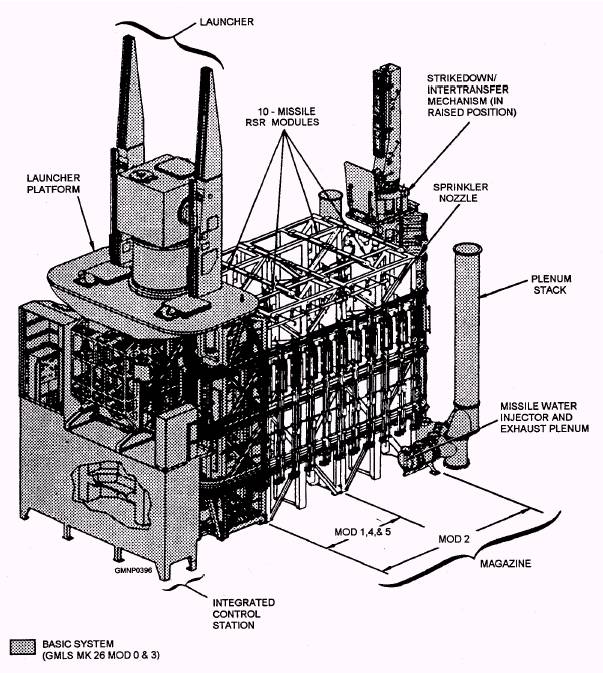
Mk 26 Standard-MR launcher
The last of the non-VLS systems was the Mk 26, used on the Virginia class CGNs, Kidd class DDGs and the first five units of the Ticonderoga class. It was a twin-arm Tartar-length system, although Tartar was long gone, and it only carried Standard, with each arm able to fire as fast as a Mk 13. It also had the capability to use ASROC, although apparently not Harpoon, and also the ability to carry nuclear-tipped weapons, which couldn't be used from the earlier Tartar launchers because of access concerns.4 These launchers marked a return to the "Coke machine" setup of the first Terrier launchers, with a modular design that allowed magazines of 24, 44 or 64 missiles. Ultimately, they were the end of the line, and were swiftly replaced by the Mk 41 Vertical Launch System, which could handle not only Standard and a new vertical launch version of ASROC, but also Tomahawk, transforming the mission of the surface warship as it gained the ability to strike far inland. But the history of VLS is a topic for another time.
1 VLS requires that the missile slew itself over, which is easy enough today, but would have been very difficult back then. Despite this, the British investigated it for what ultimately became Seaslug in the 1940s, although it wasn't implemented. Seaslug was also interesting for the decision to minimize length even at the cost of increased diameter to make storage and handling easier. This resulted in an unusual configuration where four boosters were attached around the nose of the missile. ⇑
2 And, the Gunner's Mate Missile training manual makes it quite clear, they were never to be used if the missile had a nuclear warhead. ⇑
3 Information from the fabulous Talos launcher writeup on the Okieboat website. ⇑
4 I wouldn't be surprised if these ships carried nuclear ASROC, but the nuclear Standard program died off in the 80s. ⇑

Comments
Very cool explanation and cutaways. I'd seen the Talos videos on youtube, but some of the layout wasn't particularly clear.
So what was the overall rate of fire of these early systems? How many shots would they get against a group of planes, or long range ASMs?
@echo, go check on the quoted Okieboat website, there is enough info on the Talos system to make you nauseous... :-D
That Okieboat site is the exemplar of what every warship history site should be.
@echo
Most of these systems were illuminator-limited rather than ROF-limited, but it was typically 30 seconds-1 minute for the Talos and Terrier systems. Tartar was much faster.